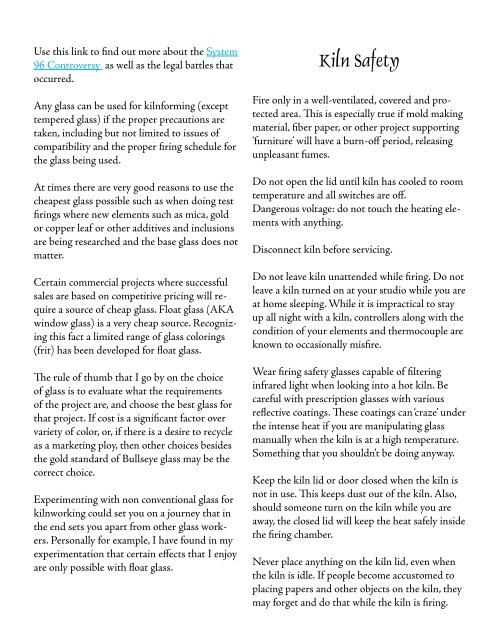CAFAC Introtroduction To Klinformed Glass
Intro To Kilnformed Glass Contents - Jim Boles Designs
Intro To Kilnformed Glass Contents - Jim Boles Designs
- No tags were found...
You also want an ePaper? Increase the reach of your titles
YUMPU automatically turns print PDFs into web optimized ePapers that Google loves.
Use this link to find out more about the System<br />
96 Controversy as well as the legal battles that<br />
occurred.<br />
Any glass can be used for kilnforming (except<br />
tempered glass) if the proper precautions are<br />
taken, including but not limited to issues of<br />
compatibility and the proper firing schedule for<br />
the glass being used.<br />
At times there are very good reasons to use the<br />
cheapest glass possible such as when doing test<br />
firings where new elements such as mica, gold<br />
or copper leaf or other additives and inclusions<br />
are being researched and the base glass does not<br />
matter.<br />
Certain commercial projects where successful<br />
sales are based on competitive pricing will require<br />
a source of cheap glass. Float glass (AKA<br />
window glass) is a very cheap source. Recognizing<br />
this fact a limited range of glass colorings<br />
(frit) has been developed for float glass.<br />
The rule of thumb that I go by on the choice<br />
of glass is to evaluate what the requirements<br />
of the project are, and choose the best glass for<br />
that project. If cost is a significant factor over<br />
variety of color, or, if there is a desire to recycle<br />
as a marketing ploy, then other choices besides<br />
the gold standard of Bullseye glass may be the<br />
correct choice.<br />
Experimenting with non conventional glass for<br />
kilnworking could set you on a journey that in<br />
the end sets you apart from other glass workers.<br />
Personally for example, I have found in my<br />
experimentation that certain effects that I enjoy<br />
are only possible with float glass.<br />
Kiln Safety<br />
Fire only in a well-ventilated, covered and protected<br />
area. This is especially true if mold making<br />
material, fiber paper, or other project supporting<br />
‘furniture’ will have a burn-off period, releasing<br />
unpleasant fumes.<br />
Do not open the lid until kiln has cooled to room<br />
temperature and all switches are off.<br />
Dangerous voltage: do not touch the heating elements<br />
with anything.<br />
Disconnect kiln before servicing.<br />
Do not leave kiln unattended while firing. Do not<br />
leave a kiln turned on at your studio while you are<br />
at home sleeping. While it is impractical to stay<br />
up all night with a kiln, controllers along with the<br />
condition of your elements and thermocouple are<br />
known to occasionally misfire.<br />
Wear firing safety glasses capable of filtering<br />
infrared light when looking into a hot kiln. Be<br />
careful with prescription glasses with various<br />
reflective coatings. These coatings can ‘craze’ under<br />
the intense heat if you are manipulating glass<br />
manually when the kiln is at a high temperature.<br />
Something that you shouldn’t be doing anyway.<br />
Keep the kiln lid or door closed when the kiln is<br />
not in use. This keeps dust out of the kiln. Also,<br />
should someone turn on the kiln while you are<br />
away, the closed lid will keep the heat safely inside<br />
the firing chamber.<br />
Never place anything on the kiln lid, even when<br />
the kiln is idle. If people become accustomed to<br />
placing papers and other objects on the kiln, they<br />
may forget and do that while the kiln is firing.


